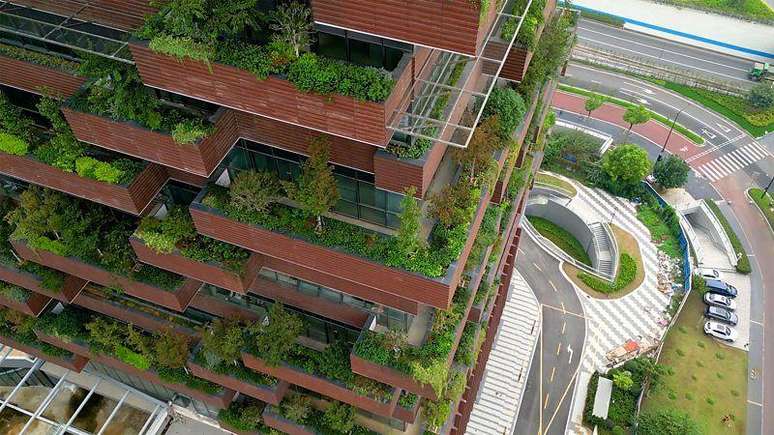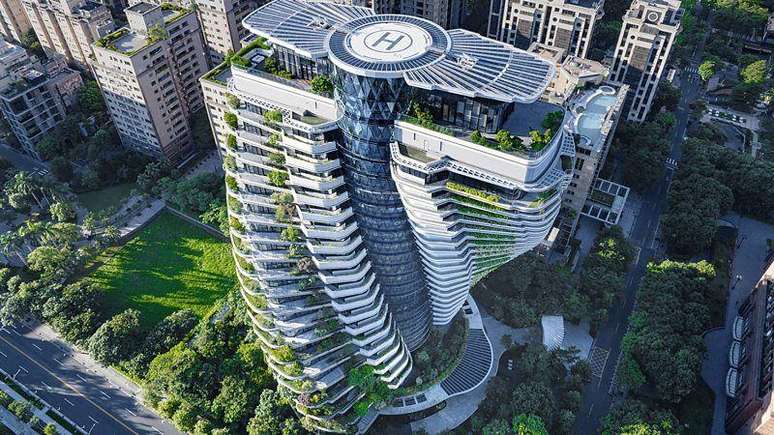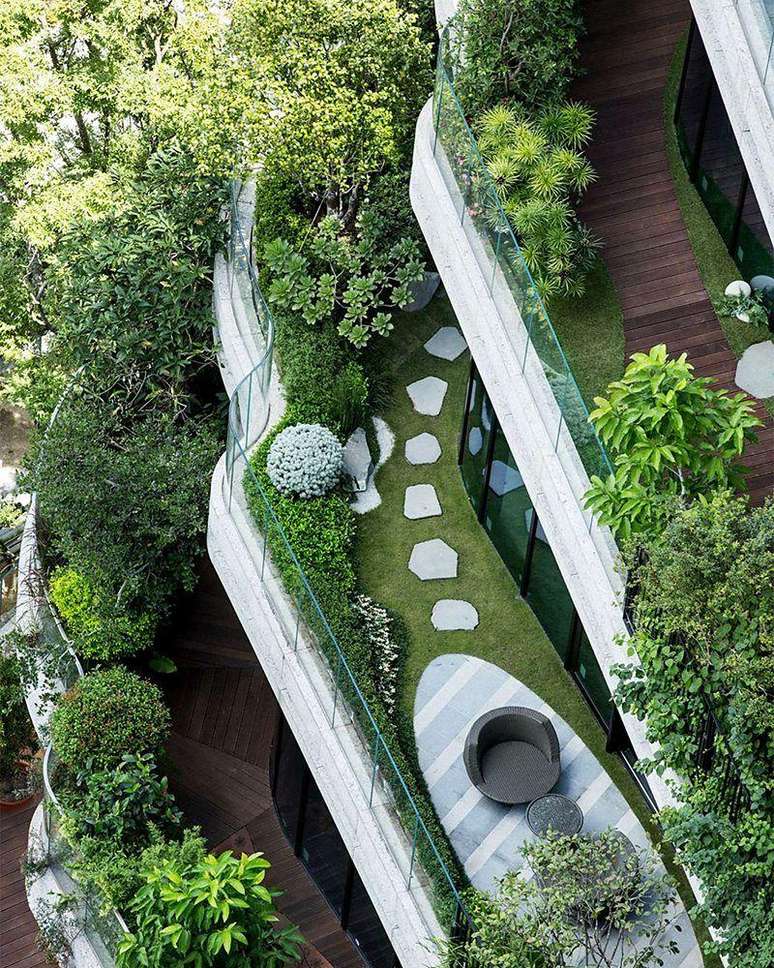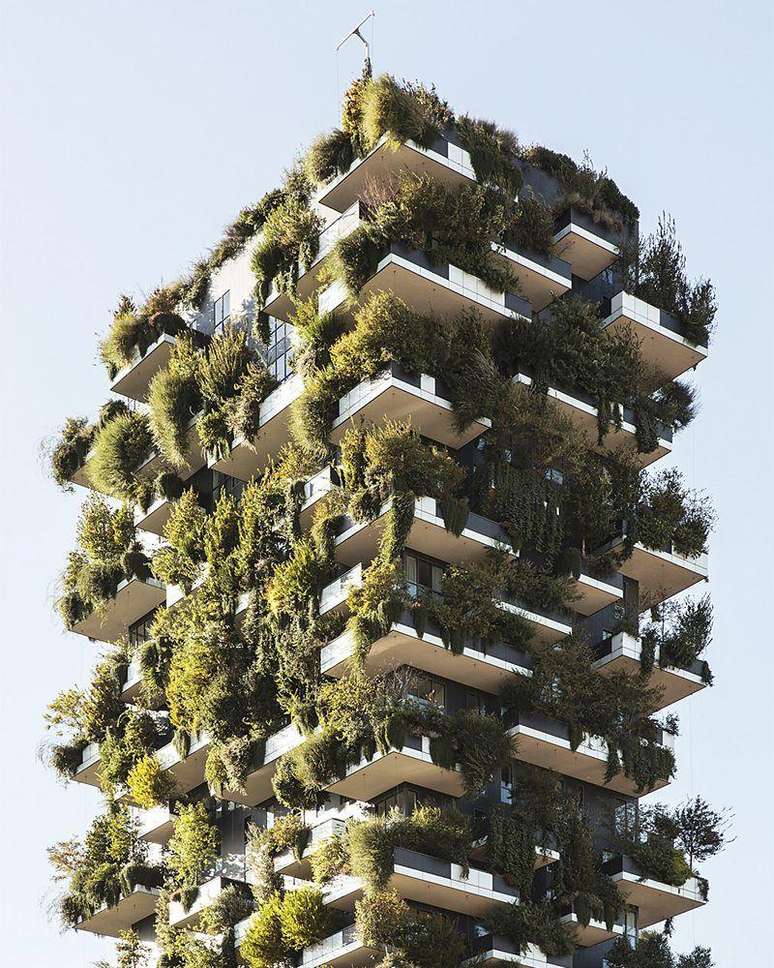The 'vertical forests' that are transforming cities

In 2007, Italian architect Stefano Boeri witnessed the frantic construction of a city in the Dubai desert, in the United Arab Emirates.
The place was dominated by skyscrapers covered in glass, ceramic and metal, wasting energy.
These materials "reflected sunlight, generating heat in the air and, mainly, in the urban soil, where pedestrians walk", he tells the BBC.
Three thousand miles away, Boeri had just begun work on his new project of two very tall buildings in a run-down area north of Milan, Italy.
"Suddenly it occurred to me to create two biological towers... covered not with glass but with leaves," he recalls.
His project would invite fauna and flora to occupy that industrial desert and cool the internal and external air. A new and radical architectural prototype emerged, which "integrates living nature as a constituent part of the project", according to him.
The surprising result was the world's first "vertical forest."

The project completed 10 years and won numerous awards.
Their plants, tended by "flying gardeners", have taken over the sides of buildings. They cool the temperature by up to 3ºC, as the foliage releases water vapour and filters sunlight.
To celebrate the anniversary, Stefano Boeri Architetti has published a new book, called Bosco Verticale: Morphology of a Vertical Forest.
The book includes essays by experts examining the intersection of nature and architecture, as well as images by architectural photographer Iwan Baan.
The book follows the evolution of the project and the principles incorporated into it.
For publisher Rizzoli, responsible for the publication, the work "celebrates an architectural work that has become a symbol of a renewed collective sensitivity in relation to caring for the environment and the plant world".
Housing for people and birdsReversing the usual architectural hierarchy, the book describes the vertical forest as "a home for trees and birds, which also shelters humans."
The work is based on texts and philosophies that influenced her, such as the book The Secret Life of Trees, from 2006.
Written by British biologist Colin Tudge, the text explains the fundamental role played by trees in our lives, sequestering carbon, producing glucose and providing shade.
Bosco Verticale also mentions British ethologist Jane Goodall. She warns that as the human population increases, "it is extremely important that this growth be accompanied by new incentives to bring the natural world into existing cities and into the planning of new municipalities."

Since the opening of Milan’s Vertical Forest, a wave of green, plant-rich buildings has begun to reintroduce nature into our cities – from Dubai in the UAE to Denver in the United States; and from Antwerp in Belgium to Arlington in the US state of Virginia.
And Africa's first vertical forest is set to open in Cairo, Egypt, later this year.
In response to critics who doubted the economic viability of the concept, the Trudo Vertical Forest opened in Eindhoven, the Netherlands, in 2021 - a social housing project with a maximum rent budgeted at 600 euros (around R$3,830) per month.
Sense of connectionIn Montpellier, in the south of France, a third of the Secret Gardens will be reserved for affordable housing.
This is a commercial reforestation project, designed by Vincent Callebaut Architectures, based in the French capital, Paris. The inauguration is expected to take place later this year.
Integrating practices such as green roofs and water recycling, the Secret Gardens also "combat the climate crisis by restoring the connection between humans and nature", Vincent Callebaut tells the BBC.
"By turning residents into urban gardeners and facades into carbon siphons, this building demonstrates that ecology is not a constraint, but a lifestyle philosophy," he explains.

The power that these extraordinary structures have to change people's lives and feelings is fundamental to their design.
One of Vincent Callebaut Architectures’ latest projects is the Rainbow Tree in Cebu, Philippines. The project is inspired by the psychedelic colors of the bark of the rainbow eucalyptus tree, which is native to the region.
The "tree" requires the cooperation of residents in each of its 300 apartments to maintain its lush flora. All of this, combined with shared greenhouses and urban beehives, helps "encourage social bonds," according to Callebaut, creating a sense of community and connection.
This notion that biophilic designs (based on the innate connection between humans and nature) can positively affect our well-being is confirmed by recent research.
A study conducted by Wageningen University in the Netherlands concluded that plants in a workplace not only make it more attractive, but also increase employee satisfaction.
Professionals also noted that plants improve air quality and that they report fewer health problems.
In Wales, a 10-year study looked at the incidence of anxiety and depression in 2.3 million medical records.
The study linked a higher level of greenery in the neighborhood to 40% less anxiety and depression than among people who lived in areas with less vegetation.
People in poorer areas saw greater benefits, with access to green spaces and water reducing the risk of anxiety and depression by 10%, compared with 6% in wealthier areas.

So it’s no surprise that new hospitals are embracing biophilic concepts.
Hospiwood 21 in La Louvière, Belgium, is another Callebaut project.
The building, according to the architect, "incorporates therapeutic vertical forests, using plants to reduce patient stress and promote recovery." It includes a relaxing biophilic interior filled with cascading plants.
In Italy, the new Policlinico Hospital of Milan, designed by Stefano Boeri, will include a green roof covering more than 7,000 square meters.
For Boeri, biophilia is part of the remodeling of healthcare facilities.
It "opens a new perspective on rehabilitation, going beyond the traditional concept of a building intended for the simple long-term care of patients, becoming a true space for interaction and well-being, in close contact with nature."
Indeed, the green branches of biophilic design are spreading across a huge variety of buildings.
Jewel Changi Airport in Singapore is a 10-storey retail and leisure complex.
Open to passengers and visitors since 2019, it is home to lush indoor forests that include 1,400 trees, as well as the world's tallest indoor waterfall, at 40 meters.
In the Dutch capital Amsterdam, the sustainable bamboo interior of the Jakarta Hotel, opened in 2018, includes a tropical garden in its central atrium.
Watered by rainwater from the roof, it quickly advances towards its 30-meter-high ceiling.
An hour away in Rotterdam, also in the Netherlands, a green roof, almost 40 meters above ground level, crowns The Depot, a publicly accessible warehouse that houses the vast art collection of the Museum Boijmans van Beuningen, in the shape of a giant mirrored cauldron.
In addition to lifting our spirits, skyscraper forests can play an important role in combating climate change.
The Tao Zhu Yin Yuan building in Taipei, Taiwan, is another Vincent Callebaut project - a 21-story tower shaped like a double DNA helix, set to open in 2024.
Its 23,000 plants absorb around 130 tonnes of carbon dioxide (CO2) per year. And its façade cooling effect reduces the need for air conditioning by 30%.
The building features rotating balconies to maximize exposure to sunlight, and its central ventilation chimneys reflect Callebaut's interest in biomimicry, the emulation of nature's systems to provide solutions to human problems.
Chimneys work like lungs. They take in air at their base and purify it, to expel it at the top.

Much taller than they are wide, vertical forests also minimize soil sealing, freeing up space for nature and reducing the risk of flooding.
“My projects embody the vision that cities are no longer problems for the climate, but rather living solutions,” says Callebaut.
Far from being "an obstacle or ornamental complement", nature is the guiding principle of the project.
The buildings now serve as "inhabited trees", he says, "which absorb carbon dioxide, produce energy and shelter biodiversity".
Biophilic buildings help combat two serious crises of our time - global warming and declining mental health - and are already considered part of fully reforested cities.
In Liuzhou, in the Chinese province of Guangxi (one of the regions most affected by smog — smoke-contaminated fog — in the world), Forest City is a futuristic project by Stefano Boeri.
It will house around 30,000 residents and generate all of its own energy. The project has been approved and is awaiting construction.
The Smart Forest City in Cancún, Mexico, aims to ban combustion-powered vehicles. It is another project by the same architect, which is awaiting a permit to begin construction.
Back in Milan, the building that started it all, with its solar panels on the roof, is undoubtedly like a tree, receiving solar energy and drawing water from the soil.
"Nature is not something that exists in an immemorial past," according to writer and philosopher Emanuele Coccia, in the book. "It is and always will be our technological future."
For Boeri, the twin vertical forests he created in Milan are not just buildings, but "a political manifesto" with "a simple and popular message: living nature must return to inhabit the spaces designed for human beings. No more, no less."
The book Bosco Verticale: Morphology of a Vertical Forest was edited by Stefano Boeri Architetti and published by Rizzoli.
Read the original version of this report (in English) on the BBC Culture website .
 BBC News Brasil - All rights reserved. Any type of reproduction without written authorization from BBC News Brasil is prohibited.
BBC News Brasil - All rights reserved. Any type of reproduction without written authorization from BBC News Brasil is prohibited.
terra




